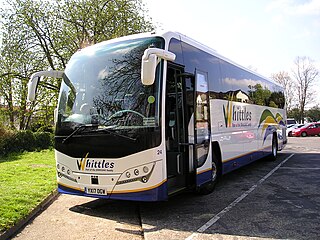
The Severn Valley Railway is a standard gauge heritage railway in Shropshire and Worcestershire, England, named after the company that originally built the railway over which it now operates. The 16-mile (26 km) heritage line runs from Bridgnorth to Kidderminster, following the course of the River Severn along the Severn Valley for much of its route, and crossing the river on the historic Victoria Bridge.

Alveley is a village in the Severn Valley in southeast Shropshire, England, about 11 miles (18 km) south-southeast of Bridgnorth. It is in the civil parish of Alveley and Romsley. The 2011 Census recorded the parish population as 2,098. It is served by bus service 297 operated by Select Bus Services. It is most famously known as being the hometown of Jack Jones, a local magician.

Morden Colliery Historic Provincial Park is a 4-hectare (9.9-acre) historic provincial park near the east coast of southern Vancouver Island, British Columbia. The location off BC Highway 19 is about 102 kilometres (63 mi) by road northwest of Victoria, and 10 kilometres (6 mi) south of Nanaimo.

Highley railway station is a station on the Severn Valley Railway heritage line in Shropshire, near the west bank of the River Severn and just under a mile south-east of the village of Highley. Highley is the only staffed single-platform station on the line. Other stops with one platform are unstaffed halts.

Country Park Halt is an unstaffed request stop on the Severn Valley Railway heritage line in Shropshire, situated near the west bank of the River Severn, about 300 yards north of the footbridge between Highley and Alveley in the Severn Valley.

Dilhorne is an ancient parish and village in Staffordshire, three miles from Cheadle and six miles from Stoke-on-Trent. The village is within the Staffordshire Moorlands area.
The Severn Valley is a rural area of the West Midlands region of England, through which the River Severn runs and the Severn Valley Railway steam heritage line operates, starting at its northernmost point in Bridgnorth, Shropshire and running south for 16 miles (26 km) to Ribbesford, a few miles south of Bewdley, Worcestershire in the Wyre Forest.

Kiveton Park Colliery was a coal mine in the village of Kiveton Park, near Rotherham, South Yorkshire, England.
The South Yorkshire Coalfield is so named from its position within Yorkshire. It covers most of South Yorkshire, West Yorkshire and a small part of North Yorkshire. The exposed coalfield outcrops in the Pennine foothills and dips under Permian rocks in the east. Its most famous coal seam is the Barnsley Bed. Coal has been mined from shallow seams and outcrops since medieval times and possibly earlier.

Alveley Halt was a halt on the original Severn Valley Line, situated between the villages of Highley and Alveley, in the English county of Shropshire. The station, which was not re-opened by the heritage Severn Valley Railway, has been replaced by the adjacent Country Park Halt around one-quarter of a mile (0.4 km) up the line.

The Cheadle Coalfield is a coalfield in the United Kingdom. Centred on the town of Cheadle, Staffordshire and its outlying villages it lies to the east of Stoke-on-Trent and the much larger North Staffordshire Coalfield. The area has been mined for many years, with documentary evidence from Croxden Abbey citing coal mining in the 13th century.
Severn Valley Country Park is a country park in England, located near Alveley, Shropshire, 8 miles (13 km) from Bridgnorth, 7 miles from Kidderminster, roughly central in the Severn Valley. Originally the site of a huge coal mine, it is now a 126-acre (51 ha) park consisting of woodland, meadows and riverside banks with views over the River Severn and a Green Flag Award.

Whittles is a coach tour operator based in Kidderminster, England.

The Lancashire Coalfield in North West England was an important British coalfield. Its coal seams were formed from the vegetation of tropical swampy forests in the Carboniferous period over 300 million years ago.

Markham Main Colliery was a coal mine in Armthorpe, on the eastern edge of Doncaster, South Yorkshire, England. It could be seen, and was a landmark, from the nearby M18.
Coventry Colliery was a coal mine located in the village of Keresley End in northern Warwickshire, between Bedworth and Coventry, England. Closed in 1991, the site today has been redeveloped as a distribution park, owned by Prologis.

The Burnley Coalfield is the most northerly portion of the Lancashire Coalfield. Surrounding Burnley, Nelson, Blackburn and Accrington, it is separated from the larger southern part by an area of Millstone Grit that forms the Rossendale anticline. Occupying a syncline, it stretches from Blackburn past Colne to the Yorkshire border where its eastern flank is the Pennine anticline.
Barrow Colliery was a coal mine in Worsborough, South Yorkshire, England. It was first dug in 1873, with the first coal being brought to the surface in January 1876. It was the scene of a major incident in 1907 when seven miners died. After 109 years of coaling operations, the mine was closed in May 1985.
Upton Colliery was a coal mine near to the village of Upton in the West Riding of Yorkshire, England. The site was 8.5 miles (13.7 km) north west of Doncaster and 10 miles (16 km) north east of Barnsley. Coal was transhipped from the colliery by the former Hull and Barnsley Railway line.
Mainsforth Colliery was situated between Ferryhill and the small hamlet of Mainsforth in County Durham, England, United Kingdom. It was adjacent to the former Ferryhill railway station in the Ferryhill Station area of the town.













